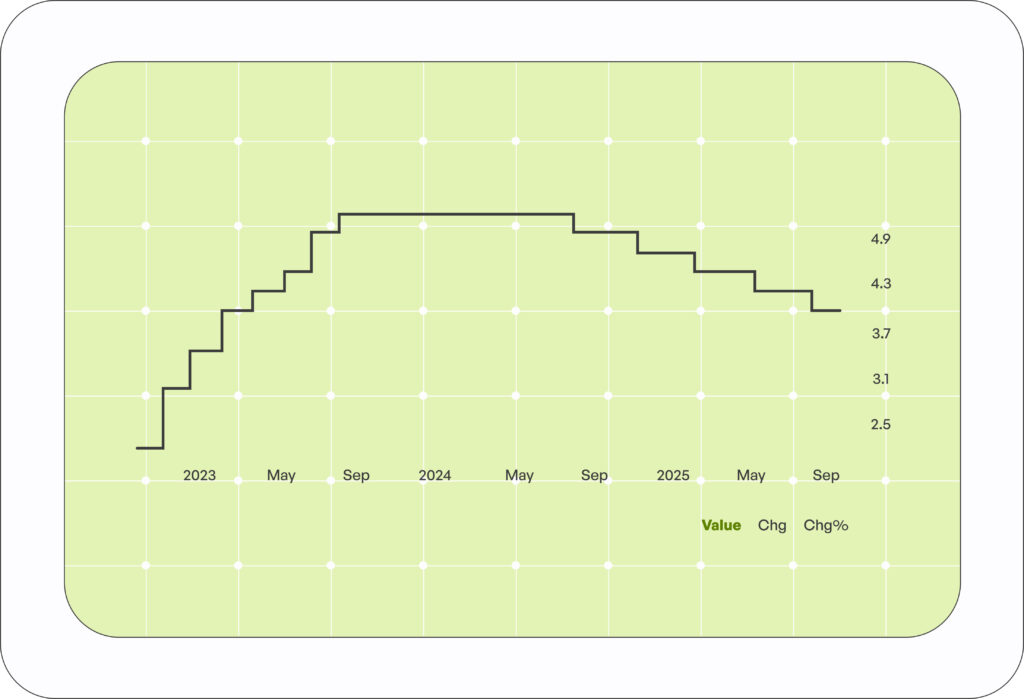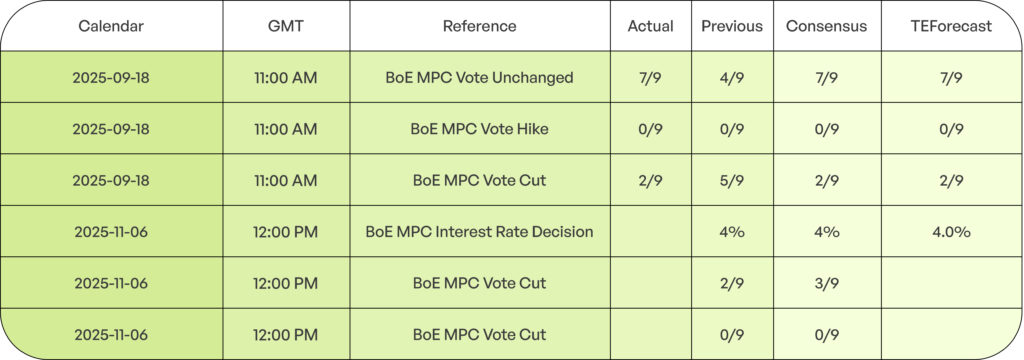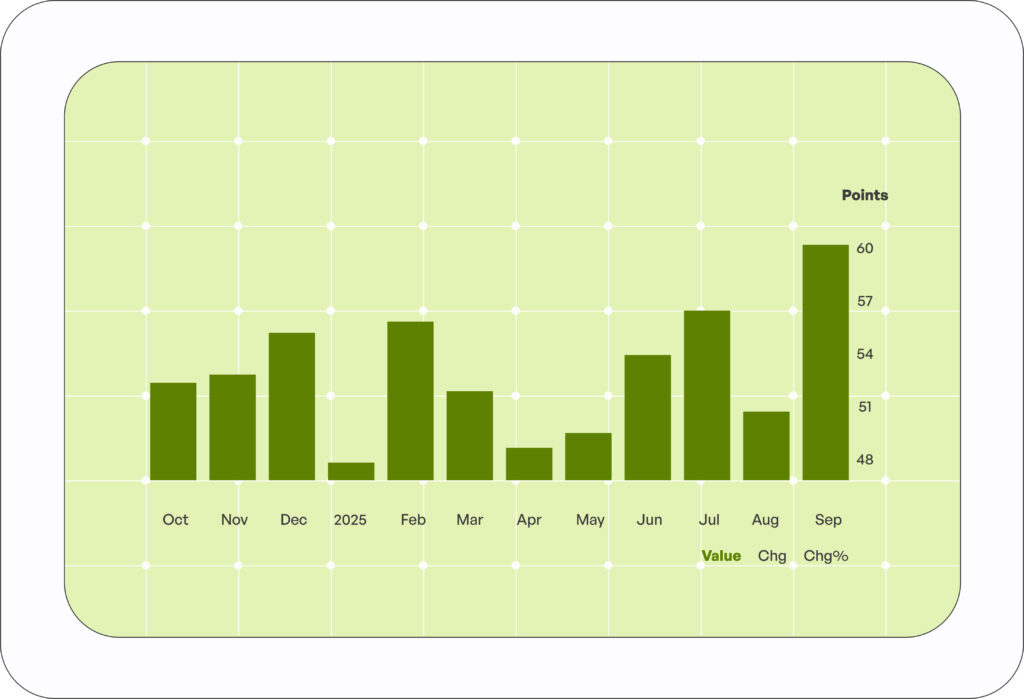One of the most delicate moments for the Bank of England (BoE) has just arrived. On the one hand, though, price pressures remain too high in the UK, while on the other hand, it is increasingly clear that the pace of economic progress is faltering. Price pressures are rising at a pace sufficient to unsettle the BoE, despite simmering weakness in wages, job growth, and business activity indicators. As a result, the BoE has decided to retain its benchmark rate unchanged at 4% as of its monetary policy decision deadline of 5th Nov, 2025, with a 5-4 decision, as four members called for a cut to 3.75%.
According to the most recent Monetary Policy Report from the BoE, “CPI inflation is judged to have peaked and underlying disinflation is underway, helped by eased wage growth, a pass-through of a fall in services price inflation, and slow labor market conditions.” On the other hand, as the BoE indicated, economic growth remains weak due to weak exports, and some sectors of the business sector have begun to contract. Construction output in the UK, for instance, has decreased at its sharpest rate in more than five years.

What emerges is a policy environment in which the BoE is caught between two conflicting imperatives: keeping monetary policy sufficiently tight to ensure inflation returns to the 2% target, while recognizing that the economy may be tipping into a phase in which demand is softening. Rate cuts may soon be on the table. As the Monetary Policy Report puts it: “If progress on disinflation continues, Bank Rate is likely to continue on a gradual downward path.”
In market terms, the odds of a rate cut have risen: recent commentary suggests the probability of a move to 3.75% is now around 30–35%. Crucially, the BoE is also watching the government’s upcoming Autumn Budget (scheduled for 26 November) and how fiscal policy—specifically tax hikes and spending plans—might affect growth, inflation, and household finances.
In short, rather than signalling a hawkish readiness to hike rates further, the BoE is signalling caution. The next move appears more likely to be a cut than another hike—unless inflation surprises to the upside or growth rebounds.

Impact on the British Pound (GBP)
For global traders, this environment makes the British Pound (GBP) less compelling relative to currencies whose central banks appear more confident about higher rates. When the BoE gives the impression that it is closer to easing, the currency typically comes under pressure.
Sterling’s value tends to weaken when markets price in earlier rate cuts or see less upside in yields. Given the BoE’s cautious stance and upward drift in cut probability, this sets a headwind for GBP performance. Unless upcoming data (inflation, wage growth, employment) surprise to the upside, the Pound’s upside is limited—and the risk of further depreciation increases.
To put it plainly: traders may decide that GBP offers less return potential than peers, so capital may instead move toward currencies backed by central banks with firmer rate outlooks and stronger economic fundamentals.
Canada’s Resilient Signals — With a Side of Caution
Turning to North America, the picture for the Canadian economy is nuanced. On the one hand, business activity signals have been encouraging: a recent analyst poll suggests the Canadian dollar (CAD) could strengthen by about 3% against the US dollar over the next three months — thanks to expectations of US rate cuts and easing trade-uncertainty headwinds.
On the other hand, Canada’s federal government budget update shows weaker growth: the economy expanded just 0.2% in the first half of 2025, and exports, business investment, and labour markets are showing strains due to trade and global headwinds.

Moreover, newer data show that Canada’s services economy rose to 50.5 in October (from 46.3 in September), indicating a return to expansion after many months of contraction. Despite this positive information, the Canadian dollar recently fell to a seven-month low against the US dollar due to the relative attractiveness of US yields and pressure on oil prices.
Altogether, Canada’s growth signals are positive and support the CAD, but there are lingering risks from weak export momentum, investment stalling, and global trade uncertainty.
Impact on the Canadian Dollar (CAD)
From a currency perspective, the modestly upbeat Canadian business data and the possibility that the Bank of Canada (BoC) will keep rates higher for longer make the CAD more appealing. When a central bank faces less pressure to cut and economic data point to resilience, the local currency tends to strengthen.
The analysts’ forecast of a CAD rally (~3%) reinforces this view. Moreover, looking ahead to November 2025, based on FX forecasts, one of the strongest currencies from high-income countries is identified as CAD, followed by the second-weakest, GBP, down approximately 2.4%.
Nevertheless, this progress of the CAD is not assured, and forces that could reverse its trend include falling oil prices, weak exports, and tighter financial conditions worldwide.
Indeed, its recent near-seven-month low versus the USD shows that upside may be muted in the short term.
For traders, the CAD currently offers a more attractive risk-return profile than GBP — especially if the BoC maintains its stance and Canada continues to defy softer global growth.

The Relative Play: GBP vs. CAD
Putting it all together, the contrast between the UK and Canada becomes clear, offering strategic insight for currency traders. The BoE’s stance leans toward eventual easing, the UK economy shows signs of stagnation or worse, and GBP appears vulnerable. Meanwhile, Canada presents a more balanced – though not flawless – story of resilience and pragmatic policy, making CAD comparatively stronger.
In a world where global investors increasingly hunt for yield and relative stability, currencies backed by stronger growth and higher expected rates tend to attract capital flows. That dynamic favours the CAD over the GBP in the current phase.
However, this is not a one-way bet. If UK inflation unexpectedly accelerates or fiscal policy surprises (positively) and growth picks up, the GBP could reverse its trend. Similarly, if Canada’s trade environment deteriorates further or oil prices collapse, CAD could lose ground. But for now, the path of least resistance appears to place GBP on the weaker side and CAD on the more advantageous side in the forex arena.
What to Watch Next
For the UK / BoE & GBP:
- Future UK CPI figures (October/November releases) and wage growth will be essential indicators of whether the BoE is likely to cut or hold.
- The Autumn Budget on the 26th of November – its tax/spending mix and growth implications will shape monetary policy views and, by extension, GBP.
- Current labour market and construction/activity statistics: weak numbers may hasten market forecasts of a rate cut, pressuring GBP.
For Canada / BoC & CAD:
- Further readings on exports, investment, and the labour market will determine whether Canada’s resilience holds.
- Oil price dynamics and trade uncertainty are key external risks for CAD.
- Market expectations for US rate cuts: If the US begins rate cuts sooner than anticipated, yield spreads could change, thereby affecting the CAD.
- Budget 2025 and any trade policy changes could influence market sentiment.
Bottom Line
The updated changes extend the divergence trend between the UK and Canadian economies. They reflect that, despite its dovish stance, the BoE is primed for future easing, as growth indicators point to a UK economic stall. On the other hand, the BoC has a solid footing, thanks to a business environment that has continued to deliver positive surprises. From a forex trader’s vantage, this means: unless the UK data turn unexpectedly strong, the main risk remains further GBP weakness. In contrast, the CAD holds a conditional ‘edge,’ especially if Canadian fundamentals stay on track and there is less concern about rate cuts. In other words, there may be more downside risk than upside for the Pound, and opportunities may be forthcoming for the Canadian Dollar, as long as growth is sustained and shocks can be managed.
